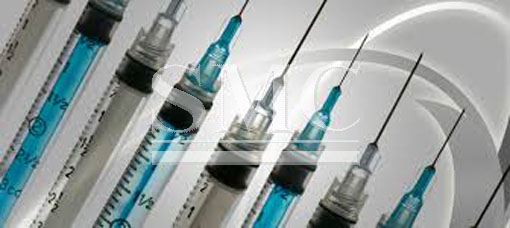Different Pokes for Different Folks
Hypodermic needles are widely used tools in the medical industry. They have many applications for things such as IV’s, vaccinations, and drawing blood. But with different applications how do medical professionals select the right gauge, length, and anatomy for the procedure?
Needle Selection
Needle selection in the medical industry is influenced on several things. What one learned in school, what is available, employee preferences, and the most comfortable needle for the patient. The two most important factors that should decide the type of needle used are the injection type and depth of penetration. Depending on the type and depth of penetration different sized needles should be used. The diameter of the needle is indicated by the gauge of the needle. All of these gauges have various available lengths. Needles commonly used in the medical industry range from 7- the largest to 33- the smallest. Size 21- gauge needles are the most common needles used for drawing and testing blood. Sized 16- and 17- gauged needles are the most common size selected for with drawing blood for blood donation. The larger needle gauge is used during this application because the wider tube allows for less pressure, which causes less damage to the red blood cells. The wider gauge also allows for more blood to be collected in a given time period, reducing the time associated with blood donation. Sized 23- and 25- gauged needles are the most common in vaccination procedures.

Production Through the Years
The 19th century saw many medical advances in medications and procedure, including the invention of the hypodermic needle. The first recorded injection occurred in 1844 by Dr. Francis Rynd as a way direct way to control the application of medicines, such as opiates and strychnine. Shortly after, Dr. Alexander Wood produced the all glass syringe in 1851, which allowed the user to estimate the dosage based on the amount of liquid in the syringe. These first needles were made entirely of silver. These needles were often sterilized and reused in patients. Dr. Wood is largely credited with the popularization and acceptance of injections as a medical technique. Since his contributions, the hypodermic needle has remained largely unchanged. However, the 1950’s saw the first fully disposable hypodermic needle. This was in response to blood shortages in the Korean War creating demand for large amounts of sterile syringes to collect blood. Also during this period, widespread immunization against polio required the development of fully disposable syringes. Today,needles are made of stainless steel, as a cheaper and stronger alternative its silver predecessor. Needles produced and distributed by Shanghai Metal Corporation come in a variety of lengths and gauges to accommodate the requirements and needs of the consumer. SMC’s needles are created with the highest of quality standards to ensure customer satisfaction and safety.
Shanghai Metal Corporation is a trusted aluminum alloy, aluminum foil price, stainless steel price and stainless steel manufacturer, kinds of stainless steel in china.
Guest contributors are welcome at the Alloy Wiki.It is a weekly wiki and guide on alloy information and processing technology, while also about the vast array of opportunities that are present in manufacturing. Our team of writers consists of a Machining Material Supplier / Machinist / Tool and Die Maker, a Biomedical Engineer / Product Development Engineer, a Job Development Coordinator / Adjunct Professor, and a President and CEO of a manufacturing facility.
Link to this article:Different Pokes for Different Folks
Reprint Statement: If there are no special instructions, all articles on this site are original. Please indicate the source for reprinting:Alloy Wiki,thanks!^^


